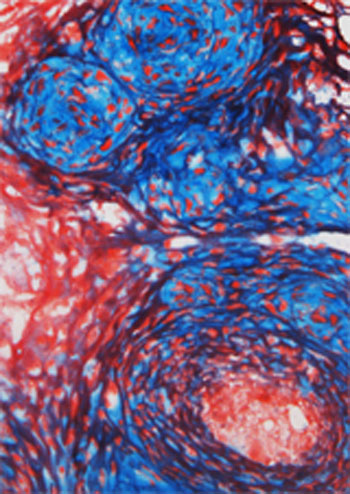Bioengineered Connective Tissue to Promote Development of Treatment Strategies
By LabMedica International staff writers
Posted on 19 Jan 2016
New models of the cellular and molecular structure of fibrocartilaginous tissues, such as those comprising the meniscus of the knee, are expected to aid in the development of treatment strategies for injuries and for age or disease-related degeneration.Posted on 19 Jan 2016
Treatment strategies to address pathologies of fibrocartilaginous tissue have been limited in part by an incomplete understanding of structure–function relationships in these load-bearing tissues. To correct this problem, investigators at the University of Pennsylvania (Philadelphia, USA) and the University of Delaware (Newark, USA) examined the fine structure of fibrocartilaginous load-bearing tissues.

Image: Heterogeneous tissue engineered constructs reproduce the microstructural, micromechanical, and mechanobiological features of the fibrous and proteoglycan-rich microdomains in native fibrocartilage. Image shows interactions between fibrous (red) and proteoglycan–rich (blue) microdomains after one week of culture (Photo courtesy of Drs. Su Chin Heo and Woojin Han, University of Pennsylvania).
Among their findings was evidence that the meniscus tissues of knees were comprised of fibrous regions consisting of long, aligned fibers that promoted tissue strength and stiffness. Yet, within the fibrous region there existed small non-fibrous microdomains that had a different composition, with concomitant different mechanical properties.
The investigators described in the January 4, 2016, online edition of the journal Nature Materials the quantification of proteoglycan-rich microdomains in developing, aging, and diseased fibrocartilaginous tissues, and the impact of these microdomains on endogenous cell responses to movement and pressure. They also described the development of a method to generate heterogeneous tissue-engineered constructs (hetTECs) with non-fibrous proteoglycan-rich microdomains engineered into the fibrous structure, and showed that these hetTECs matched the microstructural, micromechanical, and mechanobiological benchmarks of native tissue. This tissue-engineered platform is expected to facilitate the study of the mechanobiology of developing, homeostatic, degenerating, and regenerating fibrous tissues.
“To be able to probe natural tissue structure-function relationships, we developed micro-engineered models to advance our understanding of tissue development, homeostasis, degeneration, and regeneration in a more controlled manner,” said contributing author Dr. Robert L. Mauck, associate professor of orthopedic surgery and bioengineering at the University of Pennsylvania. “Our tissue-engineered constructs match the structural, mechanical, and biological properties of native tissue during the process of tissue formation and degeneration. Essentially, we are working to engineer tissues not just to provide healthy replacements, but also to better understand what is happening to cause degeneration in the first place. This engineered disease model will enable the development of new treatments for degenerative disease in numerous types of connective tissues.”
Related Links:
University of Pennsylvania
University of Delaware













